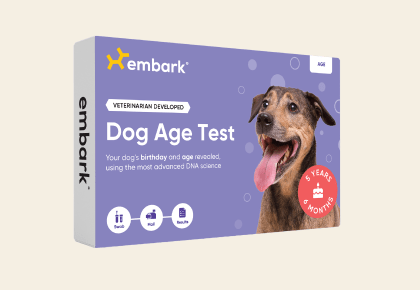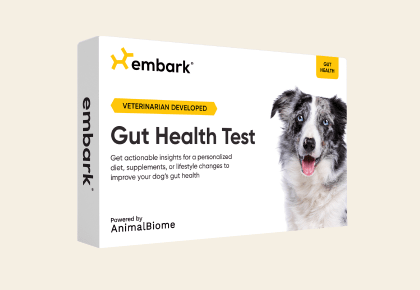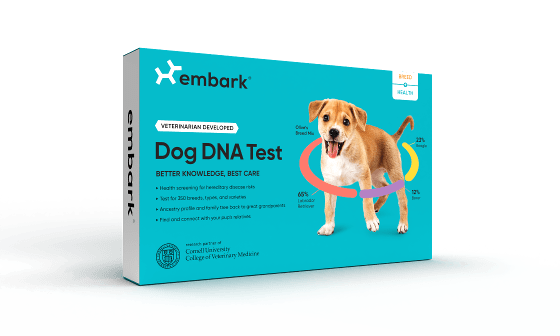Home / Resources & Insights / Archives for Mimi Padmabandu / Page 4
Mimi Padmabandu
All work
The Science Behind the Embark Dog Age Test
The Embark Age Test uses a dog’s DNA to estimate their calendar age. Specifically, it uses a type of epigenetic marker called DNA methylation. There are several physical clues that veterinarians use to estimate dog age, including body shape and lens clarity. Teeth can also indicate a dog’s age, although not all dogs follow the...
Alaskan Sled Dogs: Genetics of Canine Athletes
When we think of Alaskan sled dogs, breeds like the Siberian Husky, Alaskan Malamute, or even the Samoyed usually come to mind. These are the types of dogs popularized by movies like Snow Dogs, White Fang, Balto, and Togo. But according to Dr. Heather Huson, many other types of dogs can be modern sled dogs,...
Humans and Dogs Share More Than Just DNA
Humans and dogs have shared a lot of history. Our relationship with dogs started before the agricultural revolution, and it continues well into today. For many of us, dogs are not just pets; they are family members. The science behind why we love our dogs is extensive. Researchers are constantly uncovering new findings that help...
How to Care for Your Dog at Every Life Stage
There are several ways veterinarians estimate dog age and puppy age. Knowing a dog’s life stage can help inform what kind of lifestyle and preventive care plan are right for them. As dogs age, their social, behavioral, and health needs change. Read on to learn more about the different dog life stages and find tips...
Origins of the Australian Dingo
In 2017, Dr. Bill Ballard at La Trobe University in Melbourne, Australia won a competition to sequence the “world’s most interesting” genome. He chose the Australian dingo. Specifically, they sequenced the DNA of a desert dingo named Sandy. This work created the first full Australian dingo genome, published in a new study in 2022. The...
How a Dog DNA Test Helped Save Molly’s Life
When she brought Molly to the veterinarian for a regular physical exam, Sue Benner didn’t expect to find a genetic health risk. That surprise finding may have saved Molly’s life. Sue took Molly, her 4-month old purebred Keeshond puppy, to see Dr. Sharon Minninger at Telford Veterinary Hospital in Souderton, Pennsylvania for a physical examination...
What Makes Embark the Best Dog DNA Test?
While there are many companies out there claiming to have the best dog DNA test, Embark leads the pack. Our team is made up of scientists, veterinary geneticists, and other experts in the field who are all committed to helping dogs live their healthiest lives. Keep reading to find out why Embark offers the best...
The Most Accurate Dog DNA Test
What is the most accurate dog DNA test? The answer to that question depends on a few different factors, like what technology the test uses, how much genetic information is captured in the results, and more. Embark is proud to offer the most accurate dog DNA test on the market today. But how can you...
How Do Dog DNA Tests Work?
You probably know that DNA testing, for animals or for humans, involves sending in a saliva or blood sample and waiting for the results. But what happens to your dog’s sample after it gets to the Embark lab? Let’s break down the science behind how dog DNA tests work. How do dog DNA tests work?...
Embark Discovers Variant Associated with Hearing Loss in Rhodesian Ridgebacks
Hearing loss is one of the most common disabilities in humans and dogs. Just like humans, Rhodesian Ridgeback dogs can experience progressive hearing loss early in life. This condition is known as early-onset adult deafness (EOAD). With this form of deafness, dogs lose their hearing by the time they are 1–2 years old. Some purebred...
Embark Test Reveals Diego and Companion Dixie Are Siblings
What would you do if you found out your beloved pup would eventually become blind? When Jane Flanders Salazar got an Embark Dog DNA Test for her dog Diego, she learned that he had two copies of a genetic variant that meant he would eventually lose his eyesight. As reported in Newsweek, Jane rescued a...
The Science Behind Why We Love Our Dogs
Why do we love dogs so much? Science may have some clues about that. The human–animal bond In the early 1930s, an Austrian scientist named Konrad Lorenz kept a collection of goose eggs and waited until they hatched. When they emerged, the newly hatched goslings followed the first moving object they saw—in this case, Lorenz...








